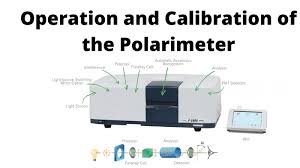Calibration of Digital Polarimeter

Calibration of Digital Polarimeter in Pharmaceuticals
1. Introduction
A digital polarimeter is used to measure the optical rotation of optically active substances, which is essential in pharmaceutical quality control for raw materials (e.g., sugars, amino acids, chiral drugs).
Calibration ensures the instrument gives accurate rotation readings in compliance with GMP and pharmacopoeial standards.
2. Objective
-
To verify and adjust the instrument’s measurement accuracy.
-
To ensure compliance with USP, EP, and JP specifications.
-
To prevent analytical errors in assays involving optical rotation.
3. Principle
Calibration is typically performed using certified quartz control plates or standard sucrose solutions of known specific rotation.
The instrument reading is compared to the certified value. Deviations beyond acceptable limits require adjustment or maintenance.
4. Equipment & Materials
-
Digital polarimeter (with temperature control if applicable)
-
Certified quartz control plate (traceable to NIST or equivalent)
-
Analytical balance (calibrated)
-
Sucrose (AR grade, dried) for solution-based calibration
-
Distilled/deionized water
-
Volumetric flasks & pipettes (Class A, calibrated)
-
Thermometer
5. Procedure
A. Calibration with Quartz Control Plate
-
Switch On the instrument and allow warm-up (as per manufacturer’s instructions).
-
Clean Optical Path with lint-free cloth and ethanol if required.
-
Insert Quartz Plate into sample compartment.
-
Record Reading from the display.
-
Compare with the Certified Value of the quartz plate at the measurement wavelength (e.g., 589 nm sodium D-line) and specified temperature.
-
Calculate Deviation:
%Error=Observed – Certified Value Certified Value×100\% \text{Error} = \frac{\text{Observed – Certified Value}}{\text{Certified Value}} \times 100
-
Accept if deviation is within tolerance (e.g., ±0.01° optical rotation or as per manufacturer’s SOP).
B. Calibration with Standard Sucrose Solution (Optional / Pharmacopeial Method)
-
Prepare standard sucrose solution of known concentration (e.g., 26.00 g sucrose in 100 mL water).
-
Measure its optical rotation at 20°C using the polarimeter.
-
Compare observed value with theoretical value calculated from pharmacopeial specific rotation constants.
-
Accept if deviation is within limits.
6. Frequency
-
Before first use.
-
At least every 6 months.
-
After maintenance or suspected malfunction.
7. Documentation
-
Instrument ID
-
Date & time
-
Calibration method (quartz plate or sucrose solution)
-
Certified value & observed value
-
Deviation & pass/fail status
-
Analyst & reviewer signature
8. Regulatory References
-
USP <781> Optical Rotation
-
EP 2.2.7 Polarimetry
-
ISO 9001 Calibration of Measurement Equipment
-
ICH Q2(R1) Method Validation
Example Acceptance Statement:
“The digital polarimeter (ID: POL-001) calibrated with a certified quartz control plate at 589 nm and 20°C showed an observed rotation of +17.750°, which is within ±0.01° of the certified value. Instrument is suitable for analytical use.”

